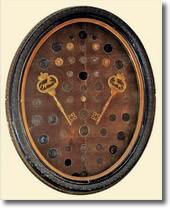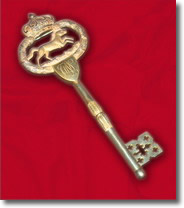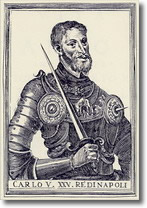
- Frame of medals with keys of the City, 19th century - Palazzo San Giacomo, Floor 2
In past centuries, symbolic keys were offered to the sovreign or the leader who made a triumphant entry into the city, probably after conquering it by political or military means; it was a sign of subjugation and respectful greeting which the representatives of the citizen's government offered their new lord according to the rules of an ancient ceremony.
Two examples of the object hich was the protagonist of this symbolic offer are to be found in a frame of medals exhibited on the second floor of Palazzo San Giacomo. The two keys, probably of the 19th century, are covered with well-preserved gilt and arranged so that they face each other as if in a mirror.
The ring of each of these keys is in the form of a garland of oak and laurel leaves with a crown among them, while in the internal space there is an unbridled horse, a symbol which was often used in representation of the city of Naples. The ring is attached to the stem by a shield on which is engraved the monogram CDN (Città di Napoli) in interwoven italic letters. The key-piece itself, or "ward", is perforated in a forom suggesting a cross "reinforced" by four small Greek crosses, that is, with arms of equal length.


